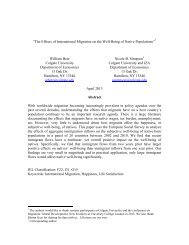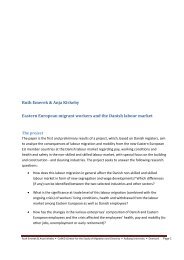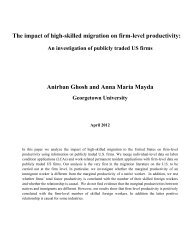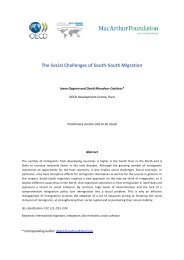The Role of Source- and Host-Country Characteristics in ... - CReAM
The Role of Source- and Host-Country Characteristics in ... - CReAM
The Role of Source- and Host-Country Characteristics in ... - CReAM
You also want an ePaper? Increase the reach of your titles
YUMPU automatically turns print PDFs into web optimized ePapers that Google loves.
groups (Fernández, 2011). <strong>The</strong> ma<strong>in</strong> difficulty <strong>in</strong> identify<strong>in</strong>g the role <strong>of</strong> culture <strong>in</strong> economic<br />
behavior is to isolate it from those <strong>of</strong> the economic <strong>and</strong> <strong>in</strong>stitutional environment <strong>in</strong> which<br />
economic decisions are taken. A possible solution to this problem is brought about by<br />
what Fernández (2011) refers to as the epidemiological approach. <strong>The</strong> ma<strong>in</strong> idea <strong>of</strong> this<br />
approach is to identify the effect <strong>of</strong> culture through the variation <strong>in</strong> economic outcomes <strong>of</strong><br />
<strong>in</strong>dividuals who share the same economic <strong>and</strong> <strong>in</strong>stitutional environment, but whose social<br />
beliefs are potentially different. One way to apply this approach is to focus on the economic<br />
behavior <strong>of</strong> immigrants. When <strong>in</strong>dividuals emigrate, they may take some aspects <strong>of</strong> their<br />
culture with them <strong>and</strong> transmit them <strong>in</strong>tergenerationally, but they live <strong>in</strong> the economic<br />
<strong>and</strong> formal <strong>in</strong>stitutional environment <strong>of</strong> the host country. Study<strong>in</strong>g the economic behavior<br />
<strong>of</strong> immigrants from different countries <strong>of</strong> orig<strong>in</strong> <strong>in</strong> their host country may therefore be a<br />
useful strategy to isolate culture from strictly economic <strong>and</strong> <strong>in</strong>stitutional effects.<br />
In this paper, we study the effect <strong>of</strong> culture on the labor supply <strong>of</strong> first- <strong>and</strong> secondgeneration<br />
female immigrants <strong>in</strong> Europe. In do<strong>in</strong>g so, our study builds on research that<br />
has exam<strong>in</strong>ed the effect <strong>of</strong> home-country characteristics on U.S. immigrant women’s labor<br />
supply. 4 An early attempt to identify the effect <strong>of</strong> culture on immigrant labor supply<br />
is the study by Reimers (1985), who uses ethnic dummy variables to exam<strong>in</strong>e whether<br />
cultural factors play a direct role <strong>in</strong> married women’s labor force participation <strong>in</strong> the U.S.<br />
As Reimers’ approach suffers from the disadvantage <strong>of</strong> not be<strong>in</strong>g explicit as to why<br />
ethnicity matters, more recent studies address this limitation by us<strong>in</strong>g quantitative variables<br />
as proxies for culture. In particular, they use past values <strong>of</strong> FLFP rates <strong>in</strong> the immigrant’s<br />
country <strong>of</strong> orig<strong>in</strong> as a cultural proxy. As Fernández <strong>and</strong> Fogli (2009) po<strong>in</strong>t out, the ma<strong>in</strong><br />
idea for us<strong>in</strong>g this aggregate variable is that it reflects the market work decisions <strong>of</strong> women<br />
<strong>in</strong> the source country, which (<strong>in</strong> addition to each woman’s <strong>in</strong>dividual characteristics)<br />
depend on the economic <strong>and</strong> <strong>in</strong>stitutional environment as well as the preferences <strong>and</strong><br />
beliefs with<strong>in</strong> the country. While the economic <strong>and</strong> (formal) <strong>in</strong>stitutional conditions <strong>of</strong> the<br />
country <strong>of</strong> orig<strong>in</strong> should no longer be relevant for emigrated women, the preferences <strong>and</strong><br />
beliefs embodied <strong>in</strong> this variable may still matter. Hence, if this aggregate variable has<br />
explanatory power for the variation <strong>in</strong> the labor market behavior <strong>of</strong> immigrant women,<br />
even after controll<strong>in</strong>g for their <strong>in</strong>dividual economic attributes, only the cultural component<br />
<strong>of</strong> this variable can be responsible for this correlation.<br />
<strong>The</strong> first study to analyze the effect <strong>of</strong> source-country FLFP rates on the work outcomes<br />
<strong>of</strong> female immigrants is the study by Antecol (2000), who f<strong>in</strong>ds the source-country FLFP<br />
rates to be positively correlated with the LFP <strong>of</strong> first-generation immigrant women <strong>in</strong><br />
the U.S. <strong>The</strong>se f<strong>in</strong>d<strong>in</strong>gs, though weaker, even hold for second- <strong>and</strong> higher-generation<br />
4 <strong>The</strong> role <strong>of</strong> source-country variables, <strong>in</strong> different contexts, has been exam<strong>in</strong>ed <strong>in</strong> several studies. For<br />
example, Borjas (1987) on the native/immigrant wage differential, Blau (1992) on the fertility behavior<br />
among first-generation immigrant women, <strong>and</strong> Antecol (2001) on the role <strong>of</strong> home-country variables <strong>in</strong><br />
expla<strong>in</strong><strong>in</strong>g variation <strong>in</strong> the gender wage gap across home-country groups with<strong>in</strong> the U.S.<br />
4







